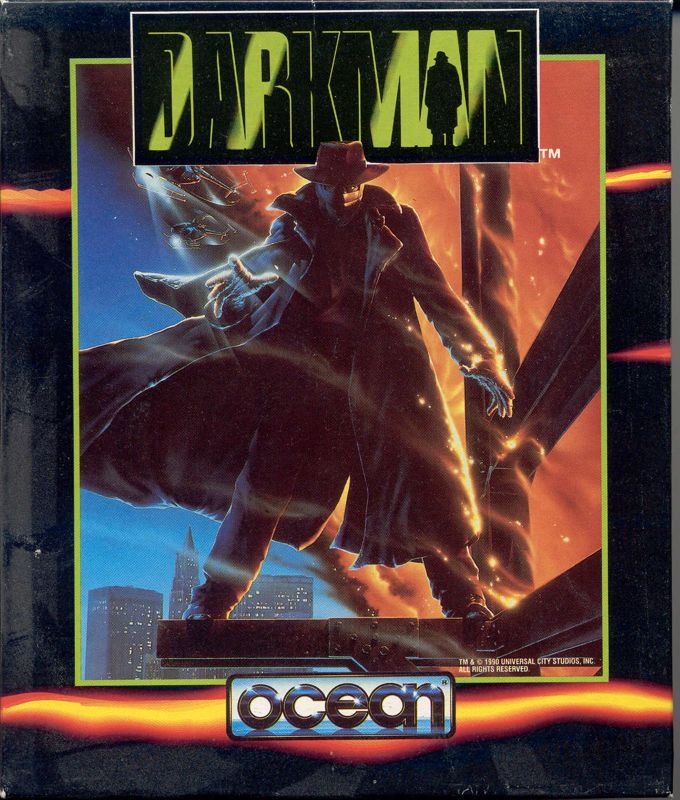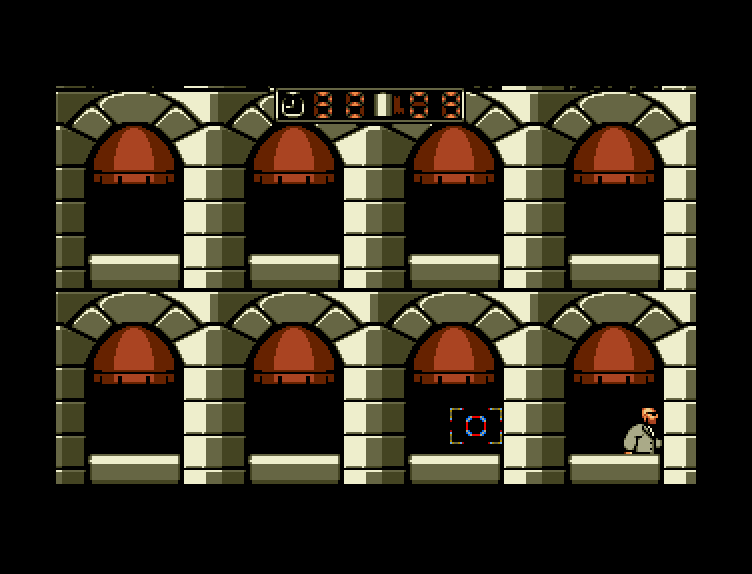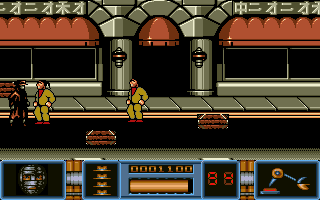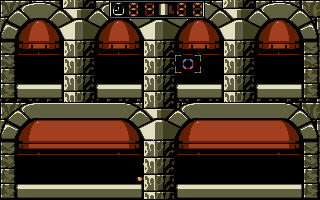Retro Replay Review
Gameplay
Darkman’s gameplay delivers a solid balance between stealth, action, and platforming sequences, making for an engaging experience that captures the spirit of Sam Raimi’s film. You step into the shoes of Peyton Westlake, the disfigured scientist turned vigilante, and navigate environments ranging from crime-ridden city streets to towering skyscrapers. Combat encounters are varied: you’ll engage in close-quarters brawls with Durant’s goons, take part in high-octane shoot-outs, and use your bandage-based disguise powers to infiltrate restricted areas undetected.
The controls feel responsive, with Darkman’s movement and attack animations flowing smoothly. The helicopter fight sequence stands out as a highlight: you cling to the moving chopper, swap between laser-sighted pistols, and time your dodges to avoid rotor blades—an adrenaline-pumping set piece that recreates the movie’s most breathtaking moment. Platforming sections, such as scaling construction beams or leaping between speeding vehicles on a busy freeway, add a pulse-quickening challenge to the action.
Level design is generally well paced, alternating between interior locales—like Durant’s opulent penthouse—and sprawling outdoor vistas, such as dockyards and freeway overpasses. While some players may find certain jump timings or enemy placements a bit unforgiving, the game offers ample ammunition and occasional hidden health pickups to keep frustration in check. Frequent checkpoint placement helps mitigate steep difficulty spikes, allowing you to immerse yourself in the game’s cinematic thrills without endless backtracking.
Graphics
For its era, Darkman boasts remarkably detailed sprite work and atmospheric lighting effects that pay homage to the film’s noir aesthetics. Character models feature expressive bandage textures, and Darkman’s flowing cloak is rendered with convincing shadowing as he moves from light to dark areas. The game’s palette leans heavily on deep blues and muted grays, evoking a gritty urban environment cloaked in perpetual twilight.
Environmental backdrops are richly illustrated, from the neon-bathed alleyways to the sleek, mirrored surfaces of Durant’s skyscraper. The helicopter fight sequence is particularly impressive, with spinning rotor blades and dynamic cityscape scrolling in the background. Subtle parallax effects add depth to each scene, while weather details—like rain streaking across the screen or steam rising from manhole covers—heighten immersion.
Enemy sprites and NPCs are distinctively designed, showcasing a variety of mobster archetypes in tailored suits, henchmen armed with tommy guns, and femme fatales who appear as mission-specific obstacles. Explosions, muzzle flashes, and debris are drawn crisply, with a satisfying sense of impact that enhances each firefight. Though modern gamers might notice some pixelation up close, the overall presentation remains evocative and stylish.
Story
Rooted directly in Sam Raimi’s film, Darkman faithfully retells Peyton Westlake’s tragic transformation and relentless quest for vengeance against the ruthless Robert G. Durant. Cinematic cutscenes bookend each major chapter, featuring key dialogue exchanges and stylized stills that capture the movie’s dramatic flair. While much of the narrative is familiar to movie fans, the game expands on certain events, offering unique missions—such as sabotaging Durant’s weapons cache—that enrich the overall plot.
The pacing of the story progression is well-judged, beginning with Westlake’s horrific laboratory accident and segueing into his descent into darkness. Each mission feels tied to the overarching revenge arc: infiltrate Durant’s hideout, rescue kidnapped colleagues, and challenge him in a climactic high-rise confrontation. Along the way, minimal but impactful voice samples—courtesy of digitized actors—deliver memorable catchphrases that reinforce Darkman’s tortured persona.
Character development is primarily visual and environmental, as Westlake’s bandaged visage and the game’s brooding soundtrack underscore his internal struggle. Objective-based dialogue prompts gently guide players without dragging down the action, ensuring that the core revenge storyline remains front and center. Though the narrative does not drastically depart from the film, it provides enough interactive expansion to hold the interest of both newcomers and diehard Raimi fans.
Overall Experience
Darkman successfully translates the film’s adrenaline-fueled set pieces into a cohesive video game adventure. Whether you’re weaving through traffic while dangling from a helicopter, battling henchmen in a sky-high gunfight, or slipping unnoticed through Durant’s lair, each mission captures the cinematic scope that made the movie a cult classic. Fans of action-platformers and superhero-themed games will find themselves engrossed in its dynamic encounters and atmospheric staging.
The game’s challenge level strikes a reasonable middle ground: it’s tough enough to keep experienced players engaged but contains enough checkpoints and health pickups to accommodate those less familiar with 16-bit era difficulty. Replay value is bolstered by hidden collectibles—blueprints that unlock concept art—and alternate paths in several levels, encouraging exploration and mastery of Darkman’s acrobatic tricks.
In sum, Darkman stands out as an ambitious movie tie-in that avoids the usual pitfalls of rushed licensed adaptations. Its polished presentation, varied gameplay mechanics, and faithful storytelling make it an appealing purchase for retro enthusiasts and anyone seeking a gritty, action-packed romp through Raimi’s shadowy world. Strap on your bandages, load your pistols, and prepare to deliver justice the Darkman way.
 Retro Replay Retro Replay gaming reviews, news, emulation, geek stuff and more!
Retro Replay Retro Replay gaming reviews, news, emulation, geek stuff and more!









Reviews
There are no reviews yet.